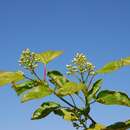Brief Summary
provided by EOL authors
Acer ginnala (Amur or Siberian maple) is a deciduous spreading shrub or small tree native to northeastern Asia, from Manchuria to northern China, Korea, and Japan, and throughout the Amur River valley. It is grown as an ornamental in northern Europe and North America, where it is known for its brilliant red fall foliage; many cultivars have been developed for different leaf shape, color and growth form. It is valued for horticulture and is used for bonsai.
A. ginnala was introduced to the U.S. in the 1860s. It is sometimes pruned to use as a hedge, and was planted as a shelterbelt (for erosion control) and for wildlife in the Northeastern and Midwestern U.S. It is cold and salt tolerant, and can grow in a wide range of soil conditions. It has escaped cultivation in some parts of the United States, and has been reported to be invasive in Connecticut, Illinois, Massachusetts, Missouri, New York, Vermont, and Wisconsin (USFS 2011). In Connecticut, it is considered potentially invasive but not yet banned. It can grow in the understory of open forests, and has sometimes been found in dense stands in Missouri and Illinois. It can also spread in open prairies.
Acer ginnala is a deciduous spreading shrub or small tree growing to 3-10 m tall, with a short trunk 20-40 cm diameter and slender branches. The bark is thin, dull gray-brown, and smooth at first but becoming shallowly fissured on old plants. The leaves are opposite and simple, 4-10 cm long and 3-6 cm wide, deeply palmately lobed with three or five lobes, of which two are small basal lobes (sometimes absent) and three are larger apical lobes; the lobes are coarsely and irregularly toothed, and the upper leaf surface glossy. The central lobe is often prominent, considerably longer than the leaf width. The leaves turn brilliant orange to red in autumn, and are on slender, often pink-tinged, petioles 3-5 cm long. The flowers are yellow-green, 5-8 mm diameter, produced in spreading panicles in spring as the leaves open. The fruit is a paired reddish samara (winged nutlet), maturing in late summer to early autumn.
Acer ginnala is closely related to Acer tataricum (Tatar maple), and some botanists treat it as a subspecies A. tataricum subsp. ginnala (Maxim.). They differ conspicuously in the glossy, deeply lobed leaves of A. ginnala, compared to the dull or matte unlobed or only shallowly lobed leaves of A. tataricum (Wikipedia 2011).
- license
- cc-by-nc
- copyright
- Jacqueline Courteau

